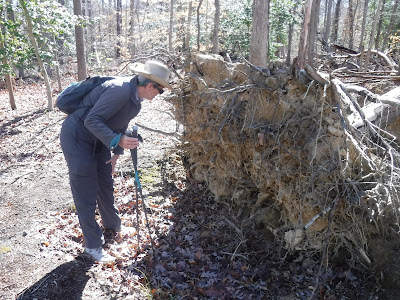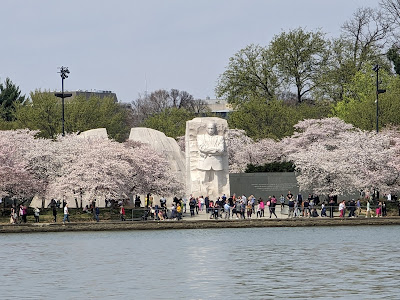Monday, March 20, 2023
Hi Blog!
This stop in North Carolina has been all about exploring different state parks. Near the geographic center of North Carolina is Raven Rock State Park, a 4,600-plus acre natural area that offers a variety of outdoor activities. We really enjoyed our visits to Eno River and Cliffs of the Neuse, so we were eager to visit one more North Carolina State Park before leaving the area on Wednesday.
Raven Rock offers over 30 miles of trails to explore on foot, bike or horseback. The park is split in two by the Cape Fear River. The north side contains the bridle trails while the south side has the hiking and biking trails. We planned several out-and-back hikes to see various parts of the park.
The first trail we took was the Northington Ferry Trail. We followed an old wagon road as it made its way down toward the Cape Fear River. We stopped for lunch at a convenient bench and noticed someone created a balanced rock on a nearby stump. Kathy tried to create one next to it and managed to make a mess. This is the original rock art:
[Ed: We did not take a photo of the mess. However, we did meet the artist of the original art above, as she made her way back up the trail from the river. She noticed her art work was in shambles. Kathy apologized profusely. The artist took it in good humor and said she would recreate her work.]
As we worked our way to the site of the old ferry, we had to cross a small drainage. The ferry was part of a road that stretched from Raleigh to Fayetteville and crossed the Cape Fear River via the Northington Ferry and served as the area's major transportation route.
With no way to make it across the river, the road came to an end.
Unfortunately, there was no bridge over Campbell Creek, so we had to make our way back up the old ferry road to continue our explorations.
Today may be the first day of Spring, but with temperatures in the 40s, it didn't feel like it. However, we did see some small signs that winter is leaving.
The next trail we tackled was the Fish Traps Trail. As we made our way back down toward the river. We hiked over rocks formed more than 400 million years ago by intense heat and pressure.
Before Europeans arrived in the 1700s, the indigenous peoples, Sioux and Tuscarora Indians, lived and hunted in the area. They used the channels between the rocks to set their fish traps.
Locks and dams were built along the river to facilitate navigation by boat. Raven Rock became an important landmark for river pilots. After a hurricane destroyed the locks and dams in 1859, the structures were not replaced; railroad transportation eliminated the need for river travel. As new roads were built, the ferry was closed and Raven Rock became a popular recreation spot.
The remnants of the Northington lock and dam can still be seen from our vantage point.
Pictured below are some amazing quartz erratics that decided to roll in to decorate the trail.
We often see felled trees along the trail. Sometimes we'll stop and count the rings. This is the first time we've ever seen a figure 8 core. Here, two young trees grew up next to each others. The larger, center tree, just absorbed its smaller neighbor.
As we hiked toward the fish traps, there was a family hiking in front of us. They stopped at this tree and hid a small paint rock. For the little boy's sake, we pretended we didn't see it.
On our way back up the trail, we stopped to check out the rock. The rock comes from Northeast Ohio Rocks and started its journey in April 2017. We will post our photo and location on their Facebook page. We put the rock back for the next family to find. In fact, we gave a hint about the rock to the next family we passed.
Raven Rock State Park is situated along the Fall Line, where the hard rock of the North Carolina piedmont transitions into the softer rock of the coastal plains. The site’s most prominent feature, and that which gives the park its name, is the 150-foot cliff that runs more than a mile along the Cape Fear’s southern bank. Originally called Patterson’s Rock after one of the area’s early settlers, it was renamed Raven Rock in the mid-1800s because of the large numbers of black birds that perched atop the ledges.
Since we had visited Raven Rock in 2018, we decided to call it a day and get back to camp so Ruby could have her afternoon walk. If you are curious about the views from Raven Rock, click the link to our
2018 blog, which this photo is from:
We finished our hike with a nice walk through the hardwood forests that surround the Cape Fear River. Mountain laurel shows the way.

It's going to be a busy couple of weeks as we get ready to purchase a sticks and bricks house, so our blogs will be unpredictable and spotty; but never doubt that we are thinking of all of you and your own adventures!



























































